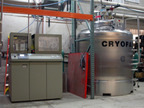CLASSE NEWS | 20 Mar 2010
Cornell's SRF group has three, 15 feet deep, magnetically shielded, and radiation-protected cryogenic test pits for the cold test of superconducting cavities. In these pits, cavities are cooled down to as low as 1.6K to analyze the electromagnetic fields that can be excited in the superconducting state. Cooling a 1m long cavity and performing the required analysis needs about 3000 liters of liquid helium. The plant is capable of liquefying 30 liquid liters per hour, requiring 4 days to prepare helium for a test, well within a test's setup time.
Helium is so light that it is not retained by the earth's gravitational potential and escapes into space. Because helium, as a nobel gas, is not bound in chemical compounds, the only helium left on earth stems from nuclear decay within the earth. Helium is therefore a non-replenishing, limited resource, which factors into the rise in cost; and capturing used helium therefore contributes to the sustainability of scientific research.
Helium liquefaction at Cornell's SRF group
On Friday, March 20, 2010, Cornell's SRF group for the first time liquefied helium that had been recaptured from a cryogenic cavity test. The cost of helium has strongly increased over the last few years, and the cost reduction associated with not venting used helium to the atmosphere is a large step forward for Cornell's SRF group. Saving this limited, and not replenishing resource also contributes to the sustainability of science.Cornell's SRF group has three, 15 feet deep, magnetically shielded, and radiation-protected cryogenic test pits for the cold test of superconducting cavities. In these pits, cavities are cooled down to as low as 1.6K to analyze the electromagnetic fields that can be excited in the superconducting state. Cooling a 1m long cavity and performing the required analysis needs about 3000 liters of liquid helium. The plant is capable of liquefying 30 liquid liters per hour, requiring 4 days to prepare helium for a test, well within a test's setup time.
Helium is so light that it is not retained by the earth's gravitational potential and escapes into space. Because helium, as a nobel gas, is not bound in chemical compounds, the only helium left on earth stems from nuclear decay within the earth. Helium is therefore a non-replenishing, limited resource, which factors into the rise in cost; and capturing used helium therefore contributes to the sustainability of scientific research.

